|
When it comes to air pollution, there is good news, there is bad
news, and there is reality. The good news is that during the past
three decades, environmental measures and new technologies have
helped reduce air pollution dramatically, by almost 50 percent. The
bad news is that worldwide, the atmosphere over our cities is still
smoggy, more areas are urbanizing, and the number of cars on the
road is increasing. The reality is that engineers have developed
dozens of creative methods to curb pollution, and although there is
no magic bullet, some combination of these approaches may hold the
answer. In this slide show, get to know a handful of tools for
reducing and preventing air pollution.—Lexi Krock
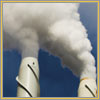

|
|
Scrubbers
Toxic exhaust from power plants accounts for much of the
nation's air pollution. Congress's 1990 Clean Air Act required
that all electric generating plants in the U.S. reduce their
emissions by 2010. In response, many plants have already added
scrubbers to their chimneys. These industrial pollution
control devices can remove toxic substances from exhaust
streams, or neutralize them so that they are harmless or even
recyclable. Ironically, the more robust the plume of smoke
rising from a smokestack, the more likely it is "scrubbed"
exhaust. So-called "wet" scrubbers can increase the proportion
of water in waste gases, plumping up smoke plumes.
|


|
|
Baghouses
Power plants often use more than one device to stop pollutants
from escaping smokestacks. Baghouses are filtration structures
such as the one seen here that have been retrofitted to many
power plants nationwide. They work by catching fine
particulates—tiny clumps of soot, dirt, and chemicals
that can damage lungs and collect in the atmosphere, creating
smog. Baghouses function as massive vacuum cleaners. They are
lined with many fabric filter "bags," which plant engineers
periodically clean or replace, carting away the particulates
they collect.
|
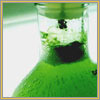

|
|
Bioreactors
While most antipollution technologies involve massive, complex
equipment, some scientists are experimenting with tiny, simple
living organisms called cyanobacteria that eat polluting
carbon dioxide (CO2). These algae can flourish in
the blistering temperatures of chimneys. Researchers have
designed "bioreactors," window-screen-like membranes teeming
with cyanobacteria, for future installation into power plant
smokestacks. Fiber- optic cables would focus life-sustaining
light across the membranes, allowing the algae to grow inside
chimneys while feasting on a diet of CO2 exhaust.
This technology has already proved itself in small-scale
demonstrations. A test on a fully operational power plant is
about five years away, and scientists are also studying the
same algae as a potential source of hydrogen energy.
|
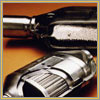

|
|
Catalytic Converters
Most cars are sources of pollution, and to keep up with
emissions laws automakers began refining car engines and fuel
systems in the 1970s. These modifications culminated in
catalytic converters, which treat exhaust before it leaves a
car's tailpipe, converting toxic combustion by-products such
as carbon and nitrogen monoxides to less-toxic gases.
Catalytic converters have been highly successful in reducing
emissions, but substantial increases in the distances cars and
trucks travel on average and in the overall number of vehicles
in use have made up the difference, and cars are still a major
cause of pollution.
|


|
|
Wind Energy
Wind is a renewable energy source that emits no pollution. It
is the fastest-growing "green" energy in the U.S. and provides
light to the Statue of Liberty. Wind farms—clusters of
huge windmills—produce electricity by using the motion
of their blades to spin a shaft connected to a generator.
Experts estimate that the electricity created in 2006 by
America's wind farms will displace some 15 million tons of
carbon dioxide. Over five million acres of forest would be
needed to absorb that much CO2. Some people oppose
wind farms because they occupy large tracts of land and can
sometimes harm birds, but most agree that their environmental
costs are much lower than those of fossil fuels.
|


|
|
Hybrid Cars
Celebrity owners have made them famous, and drivers' concerns
about skyrocketing gas prices and the environment have made
them a popular new choice. Sales in the U.S. of hybrid cars
such as Toyota's Prius, seen here, doubled in January 2006
compared to the year before, with nearly 16,000 cars sold.
Hybrids get their power from small gasoline engines combined
with electric motors and rechargeable batteries. Their compact
engines deliver excellent gas mileage and cause much less
pollution than those in conventional cars. Experts estimate
that driving a hybrid for 100,000 miles would barely fill a
teacup with pollutants.
|


|
|
Ethanol
Ethanol is a clean-burning alcohol produced by bacteria that
ferment the sugars in corn and cornstalks. Some
environmentalists tout ethanol as a potential alternative to
gasoline. In the U.S., about five million vehicles already
drive on "flex-fuel." They can use traditional gas or E85, a
mix of 85 percent ethanol and 15 percent gasoline. Converting
an automobile to flex-fuel is inexpensive, but there are few
ethanol pumps in the U.S. In Brazil, nearly all cars run on a
96 percent ethanol fuel produced from sugarcane, which is
readily available. Brazilians have seen benefits: not only is
it cleaner burning, it is half the price of imported gasoline.
|


|
|
Fuel Cell Cars
Imagine a car that only had one waste product: water. That is
the tantalizing promise of fuel cell cars, which have not yet
arrived in the commercial marketplace. If it sounds too good
to be true, that's because it might be. Fuel cell cars produce
electricity by chemically breaking down hydrogen fuel. When
pure hydrogen is used, the only by-product is water, but
pollution is produced in creating the fuel itself. Also,
because hydrogen is a flammable gas, safety is an issue. Fuel
distribution stations, such as this proposed northern
California hydrogen pump, and storage solutions are under
development but still rife with kinks. It could be two or more
decades before fuel cell cars are widely available and adopted
by drivers.
|
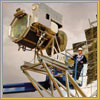

|
|
Solar Power
The sunlight that reaches Earth's surface delivers 10,000
times more energy than we consume, and solar power aims to
harness this force. Solar technologies use sunlight to provide
heat, electricity, and even cooling for homes, businesses, and
industry by conducting electrons across an array like the one
at right or like the tiny solar cell in your calculator.
Researchers have optimistically proposed that if they could
cover just 0.1 percent of the Earth's surface with highly
efficient solar cells they could in theory replace all other
forms of energy. At universities around the world, efforts are
under way to develop the kinds of advanced solar arrays using
nanotechnology and other cutting-edge science that could
perhaps accomplish this goal in the future.
|


|
|
Biodiesel
This relatively new type of alternative fuel is processed from
any vegetable oil—including used oil from fast-food
restaurants—and can power most diesel-engine vehicles
without modification. Sales of biodiesel are gradually
increasing—75 million gallons were sold in the U.S. in
2005—and many government vehicles like these from the
USDA use it to fill up. Though it burns 78 percent cleaner
than petroleum diesel and comes from a renewable source, it is
double the cost and fueling stations are scattered.
Furthermore, only a fraction of vehicles in the U.S. have
diesel engines, though new fuel-efficient models on the market
have recently gained in popularity.
|
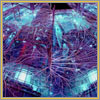

|
|
Nuclear Power
Nuclear power plants provide about 17 percent of the world's
electricity and about 20 percent of the electricity in the
U.S. They are extremely clean compared to coal-fired plants,
which, perhaps surprisingly, release more radioactivity than a
properly functioning nuclear power plant. Many experts believe
nuclear power such as that being developed in this Sandia
National Laboratory experiment is an important option for the
U.S. and the world to meet pollution-free energy needs. But
others cite significant problems with nuclear power. For
example, mining and purifying the uranium that fuels nuclear
plants is not a clean process; improperly functioning nuclear
plants present environmental and terrorism risks; spent
nuclear fuel remains toxic for centuries and must be stored;
and transporting nuclear fuel to and from plants can be
hazardous.
|

|

|

